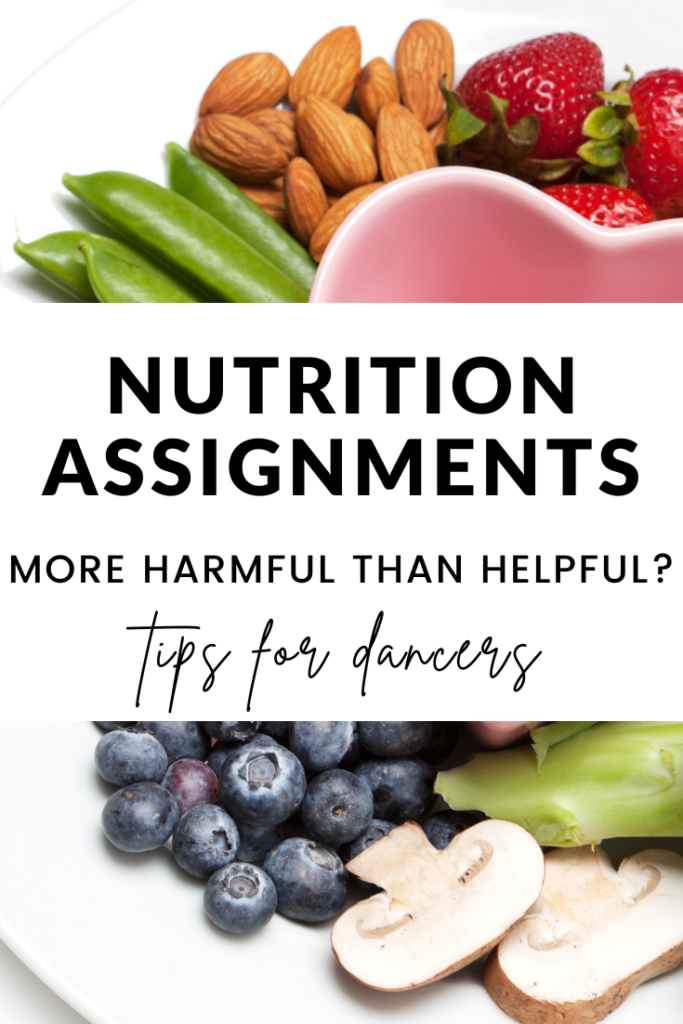In school, classes and assignments centered on the topic of nutrition can offer valuable opportunities for learning about the role of food on energy, sports performance, and disease management, to name a few. But when these assignments involve practices like food tracking and calorie counting, they can be triggering to disordered eating and self-doubt.
While it is most common for medical students and dietetic (nutrition) students to encounter these assignments in college or grad school, it’s not uncommon for a middle school or high school health class to do the same. The bombardment of diet culture can be challenging if you’re simultaneously recovering your relationship with food. Navigating these assignments requires an ability to either challenge the status quo or complete the task with resilience— an informed approach and awareness of diet culture and disordered eating is a must. In this article, we’ll uncover how to move through these assignments with less stress and more ease.
Understand the roots of health class and Nutrition 101
Most schools (including nutrition and dietetic programs) function within a weight-normative paradigm. In other words, anyone’s degree of health is a product of weight and body size. Weight loss and methods to achieve it are at the center of a weight-normative approach to health and nutrition.
But as the science of nutrition continuously evolves, we know that true health is more related to health-promoting behaviors, not simply body size and weight. This shift lays the groundwork for a weight-inclusive approach. This opens the conversation of redefining health as not a sole product of diet and exercise, but rather, a product of other health-promoting behaviors like sleep habits and stress management, in addition to social determinants of health like access to quality medical care.
But weight impacts health, doesn’t it?
Yes, weight has a profound impact on health. But this impact is more a result of both weight cycling and weight stigma. The negative treatment experienced among those in larger bodies is an independent risk factor for negative health outcomes and even increases stress— stress is a known contributor to one’s risk for the development of diabetes and heart disease.
Weight cycling, a product of dieting or restrictive eating, is also a contributor to negative health outcomes. Read more on this topic and gain a plethora of helpful resources from fellow dietitian Christy Harrison. With so much detriment from a weight-normative approach, how can students navigate the nuance of antiquated school assignments?
First, communicate with your educators
If you find an assignment to be triggering, consider discussing your concerns with your teacher or professor. Many educators are open to adjusting assignments to accommodate students’ mental and emotional well-being. Explain your worries and propose alternative ways to achieve the assignment’s learning objectives without compromising your relationship with food and body image (examples are below).
Next, plant seeds for change
You might not be able to completely change the assignment (or the systemic issue of weight normative healthcare) at large, but you can try to challenge it in small ways. For your assignment, raising questions about weight loss, including the value of BMI, is a great place to start.
Body mass index (BMI) is a value derived from the mass and height of a person. It’s a screening tool often used within weight-normative practices to assess health risks. But BMI has long been challenged and arguably, debunked. In fact, there is no evidence to support the idea of BMI (specifically higher BMI) being the cause of negative health outcomes. Rather, there’s only evidence that higher BMI is associated with certain health outcomes (those of which can also be associated with other behaviors or confounding variables like smoking status, stress, and you guessed it: weight stigma and weight cycling). Here’s an episode of Maintenance Phase that discusses the limitations of BMI (content warning: adult language). For your assignment, question the use BMI and subsequent weight goals with a few prompts:
- Who created this tool and on what population was it created?
- Is this an accurate representation of the population at large? (Spoiler: it’s not)
- Why is BMI used as a parameter for how we define health standards and is it possible for this to be wrong? (Spoiler: yes, it’s possible)
We can also open the conversation to the challenges of nutrition science— specifically how associations do not mean causations. Here’s an article that discusses nutrition research and the considerations needed before using it to draw misaligned statements (i.e. higher weight is bad for health).
Another point to consider is the conversation about disordered eating. If you’re being asked to track a few days’ worth of calories or food, then explain why these behaviors can be especially triggering of disordered eating (more on this here) and the increased vulnerability to all-or-nothing thinking that many dancers experience.
Last, lean into resilience
Navigating triggering school assignments related to nutrition, food tracking, and calorie counting requires a deep understanding of the risks of disordered eating and the harms of following a weight-normative approach to health. But there might be times when you have to complete the assignment as is— especially if your teacher or professor isn’t open to conversations about weight inclusivity. Just remember: once you attain your grade or the credentials you’ve worked so hard to achieve, you can move forward in a weight-inclusive way.
5 tips to complete nutrition assignments without feeling triggered
#1: Identify what triggers you
Before delving into the assignment, recognize potential triggers. Assignments related to weight, calories, and food intake can evoke anxiety, body image issues, or disordered eating patterns in some students. Identifying these triggers allows you to approach the assignment with self-awareness and take the necessary precautions like opting out of the assignment or requesting to replace it with an idea mentioned above.
#2: Work alongside licensed professionals
If you’re struggling to move through, don’t hesitate to reach out to those licensed for support. A mental health professional and registered dietitian nutritionist (with advanced credentialing in eating disorders) is encouraged. Professional guidance can help you navigate triggering emotions and develop coping strategies.
#3: Focus on the experience
Most often, these assignments are designed to educate, not judge. Avoid fixating solely on numbers. Approach meals and snacks as opportunities to expand your knowledge about nutrition, rather than as tools to scrutinize your eating habits. A few prompts to consider:
- How do consistent meals and snacks make me feel throughout the day?
- Do complex carbs offer me longer-lasting energy?
- Does incorporating a variety of foods in my day help to broaden my overall eating experience and challenge the potential for restrictive food rules?
Remind yourself that your worth is not determined by what you eat or how many calories you consume. Practice self-compassion and challenge any destructive thought patterns that may arise during the assignment.
#4: Swap Comparison with Personalization
Each person’s nutritional needs are unique, based on factors like age, activity level, metabolism, and health conditions. Avoid comparing your food choices to others. Instead, focus on preferences and what is accessible to you. The Healthy Dancer® Food Flexibility Algorithm is a great place to start.
#5: Add opportunities for mindful eating
Incorporate mindfulness into your approach to food. Pay attention to hunger and fullness cues, savor the flavors, textures, and aromas of your meals, and eat with intention. Mindful eating can help foster a healthier relationship with food and reduce anxiety associated with tracking. Here’s an article that talks more about mindful eating for dancers.
Nutrition degrees: What about more advanced training?
I’ve previously discussed the roadmap one takes to gaining licensure as a dietitian. For these students who are studying nutrition at a more advanced level, 6+ years of education rooted in a weight-normative paradigm might not only trigger disordered eating, but also, exacerbate the common prevalence of it among dietetic students.
Assignments that not only involve food tracking but also, mock patient encounters, become increasingly difficult for dietetic students to navigate when attempting to shift from a weight-normative approach to a weight-inclusive approach. During these instances, consider the value in conversations around weight stigma. If you live in a smaller body, then learning about thin privilege is critical, along with how to use compassionate curiosity during mock sessions. Also, discussing the harms of diet culture and the health risks associated with weight cycling is important.




